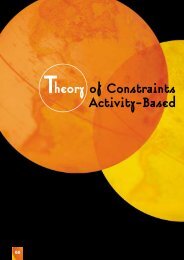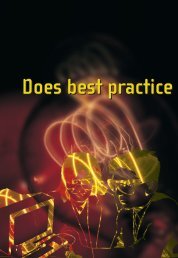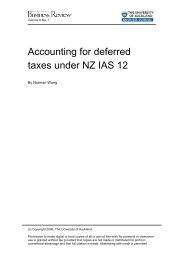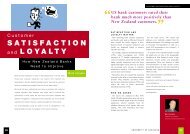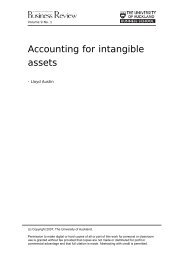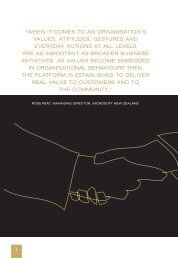Age biases in employment: - University of Auckland Business Review
Age biases in employment: - University of Auckland Business Review
Age biases in employment: - University of Auckland Business Review
- No tags were found...
You also want an ePaper? Increase the reach of your titles
YUMPU automatically turns print PDFs into web optimized ePapers that Google loves.
e s e a r c hThe field studyNegative discrim<strong>in</strong>ation, 30however, is typically 20associated with restricted 10access to tra<strong>in</strong><strong>in</strong>g anddevelopment opportunities, 10 0or to <strong>employment</strong> overall,particularly for non-managerial posts, <strong>in</strong>clud<strong>in</strong>g projects andpromotions that may be seen as “wasted” on an older workerwho is well qualified. 11 These disadvantages particularly affectthe recruitment and selection process, as an older worker whostruggles to achieve mean<strong>in</strong>gful <strong>employment</strong> is effectivelybarred from development, productivity and ongo<strong>in</strong>gexperiences with<strong>in</strong> the workplace (which may also bediscrim<strong>in</strong>atory).Shen and Kle<strong>in</strong>er 12 suggested that discrim<strong>in</strong>atory behaviours<strong>in</strong> the hir<strong>in</strong>g process occurred as a direct result <strong>of</strong> the prejudicesand stereotypes employers hold with respect to chronologicaljob category with critical skills shortages, sales as a jobclassification with moderate skills shortages and humanresource adm<strong>in</strong>istration as a job category with low skillsshortages.The third part <strong>of</strong> the research <strong>in</strong>volved <strong>in</strong>terview<strong>in</strong>g20 employers and recruiters, and hav<strong>in</strong>g them reviewthe resumes and provide “advice” to the applicantsand comment on their <strong>employment</strong> preferences moregenerally. Interviews were recorded and transcribed,and then coded thematically us<strong>in</strong>g a grounded theoryapproach.Applications for advertised positions:The study was a field experiment, carried out by us<strong>in</strong>gwritten applications and resumes to apply for 75 advertisedpositions (a method pioneered by Jowell and Prescott-Clarke <strong>in</strong> 1969, 15 and applied to age discrim<strong>in</strong>ation byBendick <strong>in</strong> 1996 16 ). The positions sought were nonmanagerial,non-entry roles <strong>in</strong> either consumer (FMCG)sales (47 positions) or general nurs<strong>in</strong>g (28 positions),neither <strong>of</strong> which are specifically age-stereotyped roles.Three-page resumes were sent <strong>in</strong> response to advertisedpositions that appeared on-l<strong>in</strong>e and <strong>in</strong> the newspaper <strong>in</strong>the greater <strong>Auckland</strong> area over a two month period. All <strong>of</strong>the positions applied forwere carefully checked forsuitability by match<strong>in</strong>g the Percentage short-listeddescription requirements100with candidate’s resumepr<strong>of</strong>ile. All three candidates’ 90resumes were sent for the 80same position once the70suitability was established.60Each <strong>of</strong> the applicant’s50resumes <strong>in</strong>cluded position-40relevant experience for the last five years, as well as arelevant (and equivalent) tertiary qualification.The key difference between the applicants was theirapparent age; the youngest was mid twenties, the middleabout 40, and the oldest approximately 55. The age <strong>of</strong> theapplicants was signalled by prior job history (presented<strong>in</strong> summary format), and year <strong>of</strong> secondary school andtertiary completion. All applicants were Anglo-Saxon maleswith “ord<strong>in</strong>ary” first and surnames. From a human capitalperspective, the candidates were equivalent, or if broaderor lengthier work<strong>in</strong>g experience were seen as relevant, thenolder workers would be preferred.The under-representation <strong>of</strong> older applicants <strong>in</strong> the f<strong>in</strong>alshort-list was statisticallysignificant <strong>in</strong> Study 1(Pearson χ2 2, 72= 8.95,p




